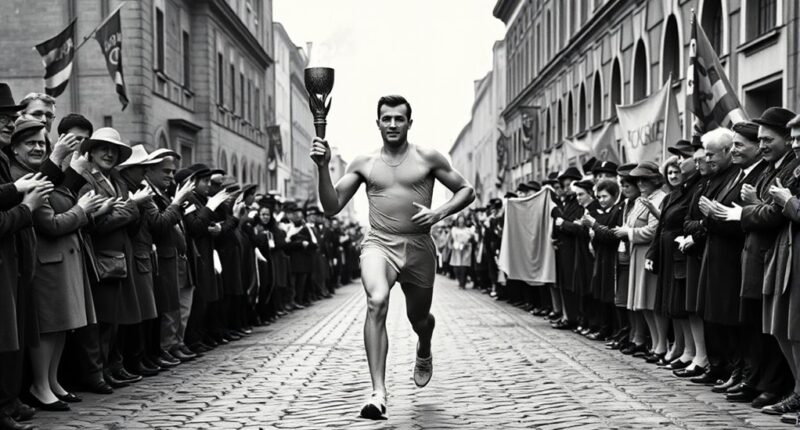The 1936 Olympic Torch Relay was originally designed as a promotional stunt by Nazi Germany to showcase their power and ideals. It involved carrying a flame from Olympia to Berlin, using carefully planned routes and symbols to promote national pride and Nazi propaganda. Over time, this event transformed into a cherished Olympic tradition, symbolizing unity and international cooperation. To discover how this simple stunt grew into a global symbol, keep exploring the story behind the relay.
Key Takeaways
- The 1936 Berlin Olympics torch relay was initially a propaganda stunt to promote Nazi ideals and showcase Germany’s strength.
- It introduced the modern tradition of the Olympic torch relay, linking ancient Greece with contemporary Games.
- The relay featured a carefully designed route, landmarks, and media coverage to maximize spectacle and national pride.
- Despite its propaganda roots, the relay was perceived by many as inspiring and fostering international unity.
- The 1936 relay set a global precedent, transforming into a lasting symbol of Olympic ideals and cultural unity.
The Origins of the Torch Relay Concept
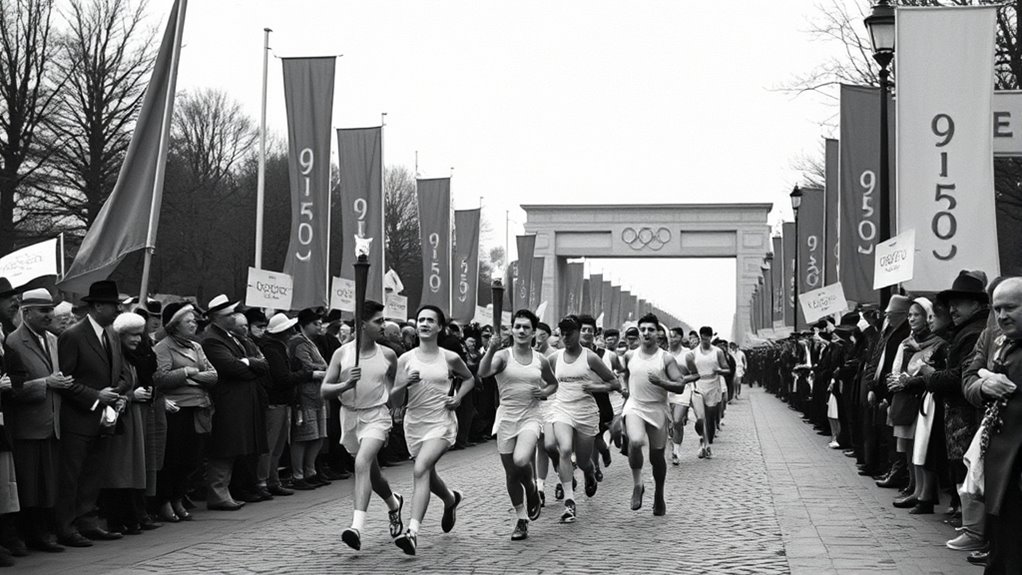
The concept of the Olympic torch relay traces back to ancient Greece, where runners carried fire from the sacred altar at Olympia to relay it to the stadium during the Games. This tradition has mythical origins, symbolizing purity, continuity, and the divine connection between the gods and athletes. The flame represented more than just a light; it embodied cultural symbolism that honored the spirit of competition and unity. In ancient times, the relay reinforced the sacredness of the Games and connected communities through a shared ritual. When the modern torch relay was revived in the 20th century, these mythic and cultural meanings persisted, emphasizing tradition and global solidarity. The symbolism of the flame has helped the relay maintain its significance across generations. Additionally, the modern adaptations of the relay have incorporated new technologies and routes to reach broader audiences and promote international unity. The history of the relay demonstrates how tradition can evolve while preserving its core message. Recognizing the cultural importance of the relay has ensured its relevance and emotional impact today. Today, the relay continues to evoke the timeless message of peace and unity rooted in its ancient, symbolic origins.
The 1936 Berlin Olympic Games and Its Context
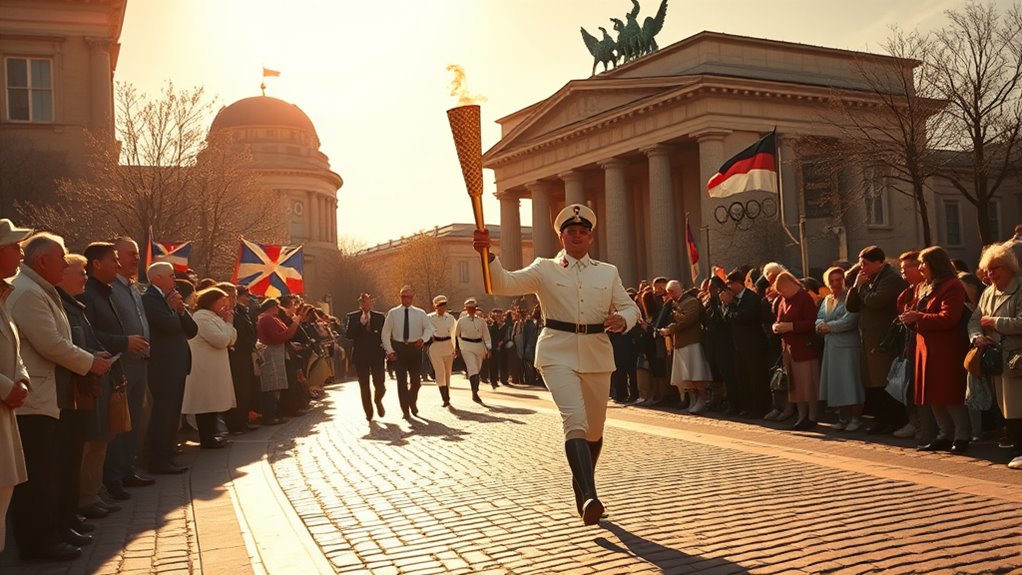
The 1936 Berlin Olympics took place amid intense political tensions, with Nazi Germany seeking to showcase its power. Propaganda was woven into every aspect of the Games, aiming to boost national pride and international prestige. Understanding this context helps you see how the torch relay became more than just a tradition—it became a tool for political messaging.
Political Climate Tensions
Why did the 1936 Berlin Olympic Games become a focal point for political tensions? The Games symbolized more than athletic prowess; they were a stage for cultural symbolism and diplomatic influence. Nazi Germany aimed to showcase its supposed racial superiority and rewrite its image globally. This tension drew international scrutiny, with many questioning whether the Olympics would become a propaganda tool. The table below highlights key aspects of this complex environment:
| Aspect | Impact | Example |
|---|---|---|
| Cultural Symbolism | Reinforced Nazi ideals | Aryan supremacy showcased in events |
| Diplomatic Influence | Global attention and diplomacy | Boycotts debated but largely avoided |
| Political Tensions | International scrutiny and protests | Critics condemned Nazi policies |
These tensions underscored the Olympics’ role as a battleground for political ideologies.
Propaganda and Prestige
As political tensions simmered around the 1936 Berlin Olympics, Nazi Germany seized the opportunity to harness the Games as a powerful tool for propaganda and prestige. They promoted a myth of unity and strength, contrasting sharply with the reality of oppressive Nazi policies. Cultural symbolism played a key role, with the Games showcasing Aryan ideals and German technological prowess. The torch relay, for example, was portrayed as a noble tradition rooted in ancient Greece, yet it also served as a modern propaganda tool, emphasizing Germany’s cultural superiority. By controlling the narrative, the Nazi regime aimed to project an image of national greatness and global respect. This manipulation blurred the lines between myth and reality, using symbolism to craft an image of power that resonated worldwide. Additionally, the event was carefully orchestrated to comply with Gold IRA regulations, ensuring that the propaganda efforts were legally sound and aligned with the regime’s broader goals. Furthermore, the use of AI security technologies in managing information helped the regime monitor and suppress dissenting voices, reinforcing their control over the narrative.
Designing the First Official Torch Relay
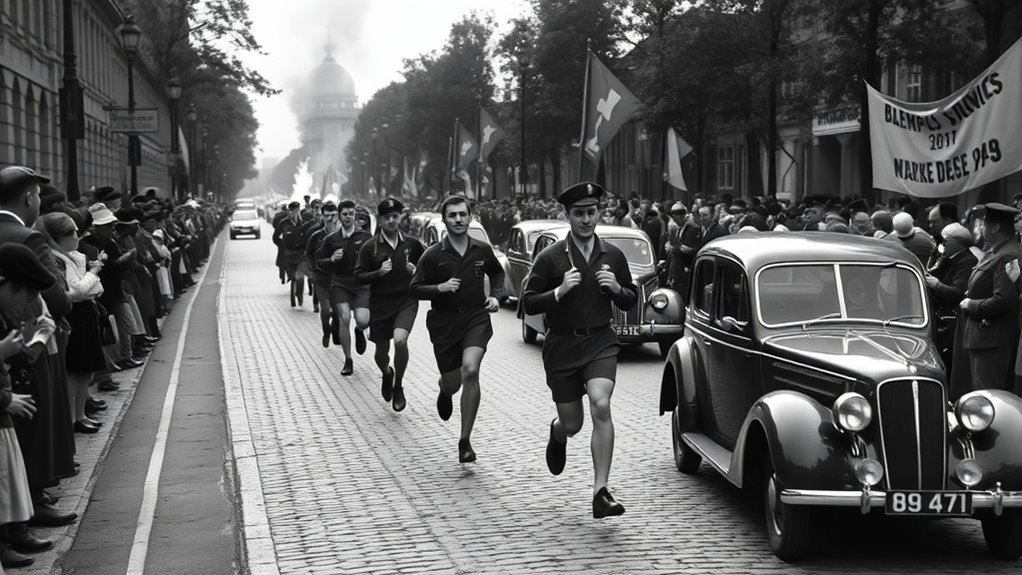
Ever wondered how the inaugural torch relay was designed to symbolize the spirit of the Olympic Games? The organizers focused on urban design to create a route that connected key cities, emphasizing unity and progress. They carefully planned the path through prominent landmarks, making the event visible and meaningful to spectators. Technological innovations played a vital role; specially designed torches used flame-retention techniques and durable materials to withstand long distances. The torch itself was a blend of traditional symbolism and modern engineering, enabling it to be easily carried and relayed. Materials used in torches were carefully selected to ensure durability and safety during the relay. Additionally, considering the weight of wind turbine blades, the design needed to account for ease of transport and handling of the torches over long distances. Modern urban planning strategies helped optimize the relay route for maximum visibility and impact. Incorporating sustainable materials into the torch design further enhanced the event’s environmental responsibility. This combination of urban planning and technological advances ensured the relay was practical, visually impactful, and aligned with the Olympic ideals of harmony and innovation. It set a precedent for future relay designs worldwide.
Symbolism and Propaganda in the 1936 Relay
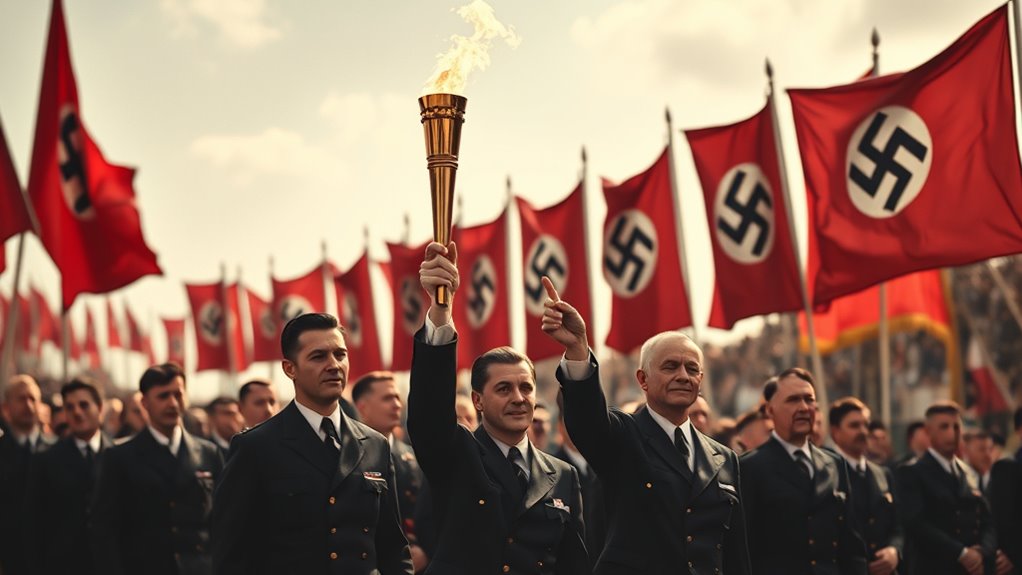
The 1936 Olympic torch relay was crafted not only as a celebration of athletic achievement but also as a powerful tool for propaganda. It used cultural symbolism to evoke a sense of unity and national pride, aligning these ideals with Nazi ideology. The torch’s flame symbolized purity and strength, reinforcing the regime’s message. You’ll notice how the relay emphasized political propaganda by showcasing Germany’s technological prowess and organizational skills. The event deliberately promoted the image of a unified, powerful nation under Nazi control.
The 1936 torch relay used symbolism and staging to promote Nazi ideals and showcase German strength.
- The torch’s design incorporated symbols representing Aryan ideals and German heritage
- The relay connected distant regions, emphasizing national unity and strength
- The event was carefully staged to project Germany’s power to the world
Public Reception and Media Coverage of the 1936 Event
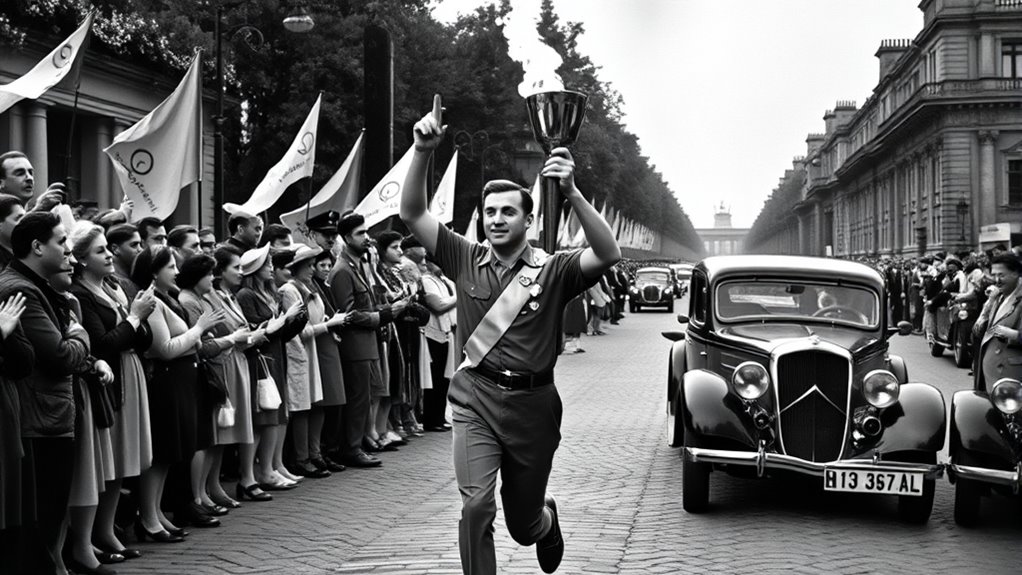
Public reception of the 1936 Olympic torch relay was largely influenced by the Nazi regime’s strategic media coverage, which aimed to showcase Germany’s strength and unity. Media outlets worldwide highlighted the relay’s grandeur, often emphasizing technological innovations like radio broadcasts and film footage that brought the event into millions of homes. Celebrity endorsements also played a role; prominent figures publicly supported the relay, boosting its visibility and credibility. These endorsements, combined with advanced filming techniques, created a sense of excitement and legitimacy. The media coverage painted the relay as a unifying and inspiring event, though it was carefully curated to serve political propaganda. As a result, the public largely viewed the relay as a symbol of national pride, despite the underlying political motives.
Evolving Traditions: From a Promotional Stunt to a Ceremony
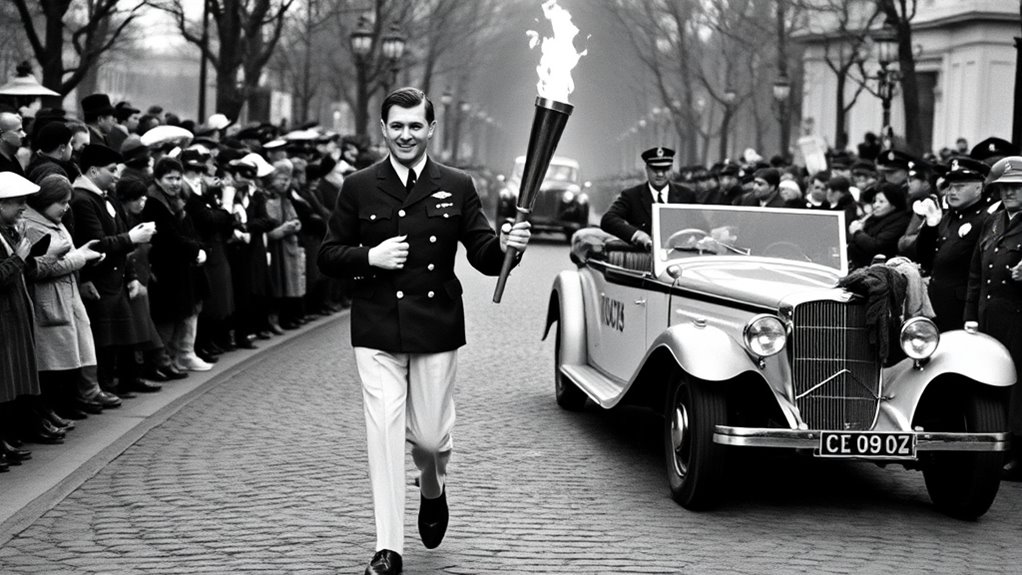
Over time, the Olympic torch relay has transformed from a simple promotional stunt into a revered ceremonial tradition. This evolution emphasizes its cultural significance and athletic symbolism, connecting past and present generations. Today, the relay symbolizes unity, peace, and the enduring spirit of the Games. You’ll notice how host countries incorporate local customs, turning the event into a celebration of cultural diversity. The torch’s journey through different regions fosters national pride and global solidarity. The symbolic act of passing the flame highlights the Olympic ideals of friendship and perseverance. These traditions deepen the emotional impact, elevating the relay from marketing tool to a meaningful ceremony that honors the history and values of the Olympics.
The Legacy of the 1936 Torch Relay in Olympic History
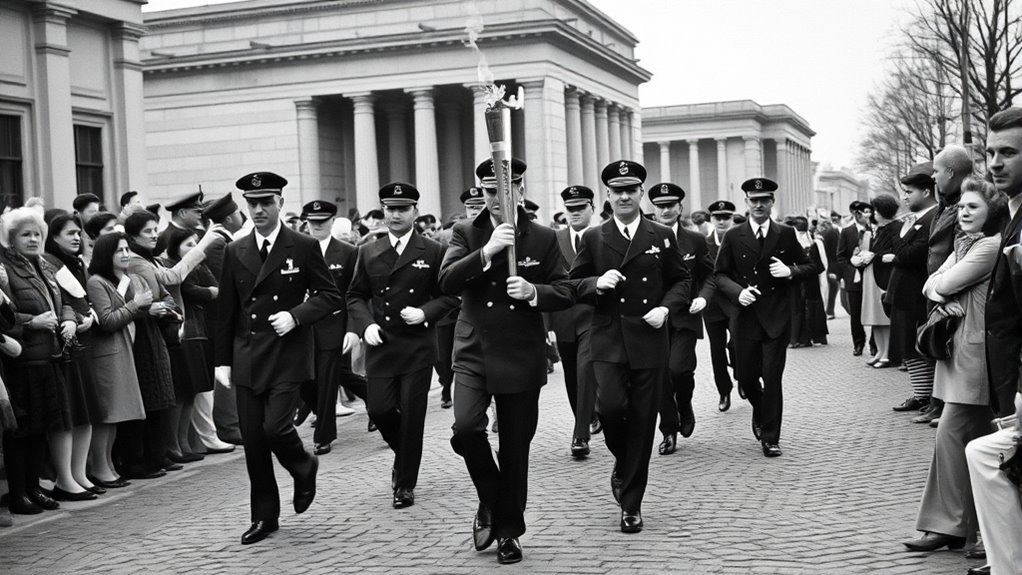
Although the 1936 Berlin Olympics are often remembered for their political and propagandistic significance, their torch relay set a pivotal precedent that shaped future Games. It established a symbolic link between ancient traditions and modern athletic unity, emphasizing cultural symbolism. This relay became a model for connecting nations through shared values, fostering a sense of global camaraderie. The relay’s success encouraged organizers to view it as more than a publicity stunt—it became an integral part of Olympic identity. The table below highlights key aspects of this legacy:
| Aspect | Impact | Significance |
|---|---|---|
| Cultural Symbolism | Reinforced historic Olympic ideals | Connected past with present |
| Athletic Unity | Promoted international cooperation | Strengthened global solidarity |
| Tradition Adoption | Became a standard Olympic feature | Ensured continuity of Olympic spirit |
How the Torch Relay Became a Global Phenomenon
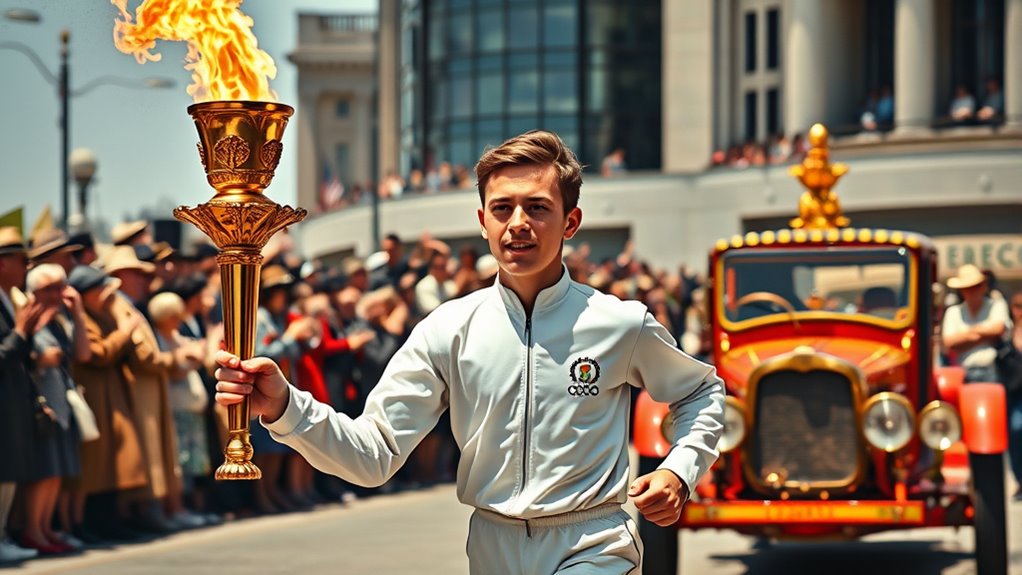
You might wonder how the torch relay grew into a worldwide event. It started with simple traditions and gradually expanded across countries. Today, modernization and global outreach keep it evolving and inspiring millions.
Origins of the Tradition
The tradition of the Olympic torch relay started in 1936 during the Berlin Games, when organizers wanted to link the ancient and modern Olympics through a symbolic act. This event introduced a powerful form of cultural symbolism, emphasizing unity and tradition across nations. Over time, the relay’s significance grew, boosting the Olympic movement’s visibility and fostering international camaraderie. The relay also began to generate economic impact by attracting tourism and media attention, benefiting host cities. As the relay expanded beyond Germany, countries adopted it as a way to showcase national pride and promote global participation. Today, the torch relay stands as a symbol of peace, unity, and tradition, evolving from its origins as a publicity stunt into a worldwide phenomenon that celebrates the Olympic spirit.
Spread and Modernization
As the Olympic torch relay gained popularity, organizers began expanding its reach beyond Germany, turning it into a truly global event. They recognized its power as a symbol of cultural symbolism, uniting diverse nations through shared ideals. By routing the relay through multiple countries, organizers fostered a sense of athletic unity that transcended borders, inspiring global participation and pride. Modernization efforts focused on increasing visibility and spectacle, incorporating new technologies and logistics to make each relay more impressive. The relay’s evolution from a German publicity stunt to an international tradition reflects its role in promoting the Olympic spirit worldwide. Today, the torch relay continues to serve as a bridge connecting cultures, emphasizing unity through sport and shared celebration.
Modern Interpretations and Controversies Surrounding the Torch Relay
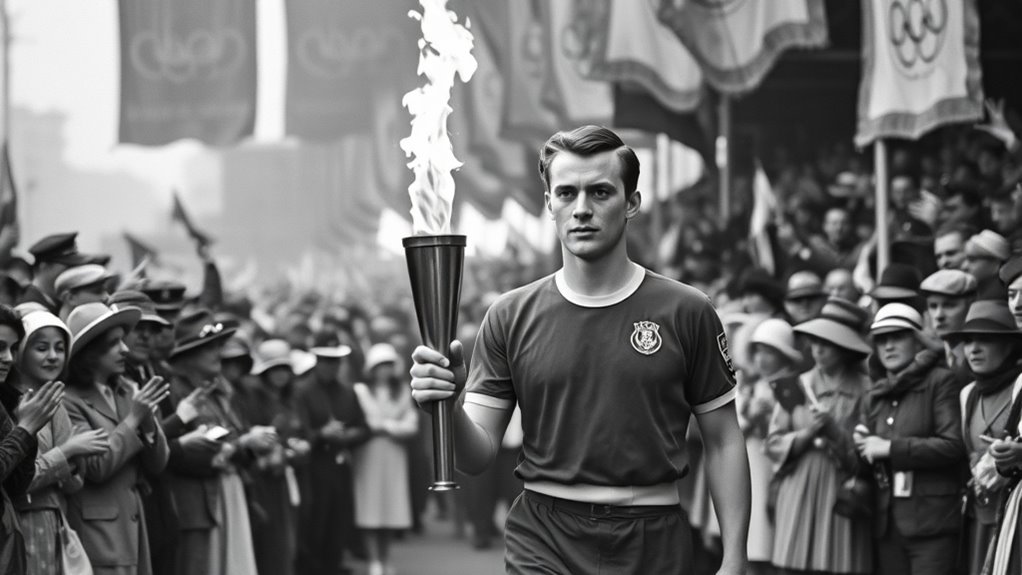
Modern interpretations of the Olympic torch relay often spark controversy, reflecting broader debates about politics, cultural sensitivity, and global unity. You might see the relay as a powerful symbol of peace, but critics argue it can be used as political propaganda or a display of cultural symbolism that excludes some communities. Some host countries use the event to promote national identity or political agendas, overshadowing the original ideals of unity. Controversies also arise over cultural insensitivity, such as the choice of route or symbolism that disregards local traditions. These debates highlight how the relay’s meaning can shift from a celebration of sport to a tool for political messaging or cultural dominance. Understanding these interpretations helps you see how the relay’s purpose evolves in different contexts.
Frequently Asked Questions
How Did the 1936 Relay Influence Subsequent Olympic Ceremonies?
You see, the 1936 relay transformed how Olympic ceremonies approach branding and tradition. It popularized the idea of a symbolic torch relay, creating a powerful visual link to the games. This tradition became central to Olympic branding, emphasizing unity and continuity. As a result, subsequent ceremonies adopted torch relays as a key element, strengthening the ceremonial traditions that make each Olympics unique and memorable for athletes and spectators alike.
Were There Any Notable Incidents or Scandals During the 1936 Relay?
Imagine running alongside the glowing Olympic torch, but during the 1936 relay, you notice tension beneath the celebratory atmosphere. There was a notable incident involving an Olympic protest, highlighting political unrest, and a torch controversy when some questioned its symbolism. These moments cast shadows over the event, revealing that even in celebration, political feelings and protests can ignite, making the relay more than just a ceremonial run.
What Was the Public’S Perception of the Relay at the Time?
You see, at the time, the public enthusiasm for the 1936 torch relay was high, as many viewed it as a symbol of unity and tradition. However, some also perceived political controversy, with critics questioning its use as propaganda by the Nazi regime. Despite this, most people embraced the relay, seeing it as an exciting part of the Olympic spirit, even amid underlying tensions.
How Did the Nazis Use the Relay for Political Propaganda?
You might think a relay is just about sports, but the Nazis turned it into a powerful political spectacle. They used Nazi propaganda to showcase strength and unity, making the torch relay a symbol of their ideology. By controlling the event, they manipulated public perception, turning a celebration into a tool for promoting their political agenda and intimidating opponents, all under the guise of Olympic spirit.
Has the Original 1936 Relay Route Been Preserved or Changed?
You might wonder if the original 1936 relay route has been preserved or changed. The route has undergone several modifications over the years, reflecting political, logistical, or commemorative reasons. While some parts of the original route are preserved as historical landmarks, others have been altered or expanded to accommodate new cities and modern transportation. Overall, route preservation varies, with certain segments remaining as a tribute to history.
Conclusion
As you see, the 1936 Berlin torch relay started as a publicity stunt that transformed into a powerful Olympic tradition. It’s fascinating how a simple promotional event evolved into a symbol of unity, perseverance, and global celebration. But as you consider its history, do you ever wonder how much of its original purpose remains today? The torch relay’s journey reminds us that even the boldest ideas can leave a lasting legacy—shaping the spirit of the Games for generations to come.
